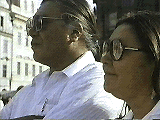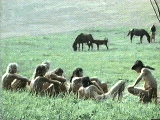


|
Interview: John Paskievich director of If Only I Were an Indian CM interviewed award-winning director John Paskievich November 9th, the night before the launch of If Only I Were an Indian at the Winnipeg Art Gallery. |
CM: During the movie the view of these Europeans who dress up as Indians changes, from seeing them from the outside, as somewhat absurd, to seeing them more sympathetically, more as they see themselves. Did your perspective change while you were making the film?
Paskievich: It changed, but not so much when I was making the movie, as when I was doing the actual research. I went over there on Aeroplan points, actually, just to see what these Czechs and Slovaks were about -- I thought I might just make a novelty piece on a bunch of eccentrics. But while I was researching them, I found there was a lot there, and that these individuals were incredibly articulate and knowledgable about the world, and my attitude changed.
CM: How would you sum up the attitude of the native elders?
 Paskievich: At first they were sceptical. They had an open mind,
but still a sceptical attitude. But then they really liked these people,
they liked what they saw and the hard work the Indian activity involves
-- everything over there is done by hand; here often the native artifacts
are made in a much more commercial fashion. Even bead-work is something
that relies on industrial goods. But the Czechs and Slovaks use only
quills, rather than beads, for decoration. Though they have to use
hedgehog quills, because there aren't any porcupines.
Paskievich: At first they were sceptical. They had an open mind,
but still a sceptical attitude. But then they really liked these people,
they liked what they saw and the hard work the Indian activity involves
-- everything over there is done by hand; here often the native artifacts
are made in a much more commercial fashion. Even bead-work is something
that relies on industrial goods. But the Czechs and Slovaks use only
quills, rather than beads, for decoration. Though they have to use
hedgehog quills, because there aren't any porcupines.
CM: What did you take away from making If Only I Were an Indian?
 Paskievich: I learned that all things are possible in human
affairs in terms of sociology or anthropology. That all things are
possible and too often we use boxes when we talk about issues like
racism, for example. That to me is always a stupid issue; there's no
such thing as race; people all blend together. But people in power seem
to want to box people in, whether it's to keep power, or to help people,
or to fight oppression. The whole issue of cultural appropriation has to
do with boxes. I find the box thinking clumsy, and it doesn't make any
sense. For instance at the Art Gallery opening (on November 10th), a
company run by natives in Manitoba is supplying the soft drinks --
they've adopted white business culture. I wanted that because it seemed
to me to parallel what these Czechs and Slovaks were doing in adopting
native culture.
Paskievich: I learned that all things are possible in human
affairs in terms of sociology or anthropology. That all things are
possible and too often we use boxes when we talk about issues like
racism, for example. That to me is always a stupid issue; there's no
such thing as race; people all blend together. But people in power seem
to want to box people in, whether it's to keep power, or to help people,
or to fight oppression. The whole issue of cultural appropriation has to
do with boxes. I find the box thinking clumsy, and it doesn't make any
sense. For instance at the Art Gallery opening (on November 10th), a
company run by natives in Manitoba is supplying the soft drinks --
they've adopted white business culture. I wanted that because it seemed
to me to parallel what these Czechs and Slovaks were doing in adopting
native culture.
CM: This is a film about culture; I have to ask what your own cultural background is.
Paskievich: I grew up in an ethnic, working-class culture; I emigrated as a boy, after the war, in the fifties. My parents were illiterate refugees. The were victims of an ideology as well. From Ukraine. That's where some of my perspective comes from.
CM: Your film couldn't help but remind me that in North America, thousands of people try to recreate European medieval history in the Society for Creative Anachronism; and here were Europeans trying to recreate North American history . . .
 Paskievich: I think you're going to see more of that; you're
going to see all kinds of people seeking a kind of cultural intimacy of
their own. In a way, we don't have a culture anymore. We have high
culture, with the opera and the symphony; and we have low culture, with
things like hockey and baseball; and then we have pop culture, which is
different from popular culture -- pop culture is all business. What we
don't have is a culture where all people get together and have rituals.
Churches used to provide that, but I think most people now, that great
middle class, are culture-less. Nobody knows how to dance or sing at
ritual events . . .
Paskievich: I think you're going to see more of that; you're
going to see all kinds of people seeking a kind of cultural intimacy of
their own. In a way, we don't have a culture anymore. We have high
culture, with the opera and the symphony; and we have low culture, with
things like hockey and baseball; and then we have pop culture, which is
different from popular culture -- pop culture is all business. What we
don't have is a culture where all people get together and have rituals.
Churches used to provide that, but I think most people now, that great
middle class, are culture-less. Nobody knows how to dance or sing at
ritual events . . .
A review of If Only I Were an Indian appears in this issue of CM

Copyright © 1995 the Manitoba Library Association.
Reproduction for personal use is permitted only if this copyright notice is
maintained. Any other reproduction is prohibited without permission.
Published by
The Manitoba Library Association
ISSN 1201-9364
 Go back to CM Welcome page
Go back to CM Welcome page
 Go back to Table of
Contents for this Issue
Go back to Table of
Contents for this Issue